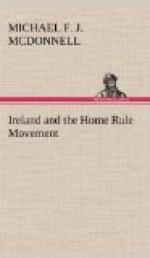Secretary, in the House of Commons last session, spoke
of the fact that he received large numbers of letters
of complaint, purporting to come from different sufferers
from violence and intimidation in Ireland, but which,
on close examination, turned out to be signed by one
man. The recent disgraceful attempt to beat up
prejudice on the part of the
Daily Graphic,
which reproduced what purported to be not the photograph
of an actual moonlighting scene, but a photograph
of “the real moonlighters, who obligingly re-enacted
their drama for the benefit of our photographer,”
incurred the disgust which it deserved; but it was
only one instance of an organised campaign of bruiting
abroad invented stories of lawlessness in Ireland
which constitutes the deliberate policy of the “carrion
crows,” whose action Mr. Birrell so justly reprobated,
and of which the most flagrant instances were the
purely fictitious plots to blow up the Exhibition
in Dublin; an outrage at Drumdoe, which on investigation
proved to be the work of residents in the house which
was supposed to be attacked, and the allegation of
a dynamite outrage at Clonroe, in County Cork, which
the police reported had never occurred. One would
have thought that the experience which the
Times
and the Loyal Irish and Patriotic Union gained at
the hands of Richard Pigott would at least have made
people chary of this form of propaganda. The comparison
of the criminal statistics of Ireland with those of
Scotland which I have made shows how much truth there
is in the imputations of widespread lawlessness, as
does also the number of times on which in each year
the Judges of Assize comment favourably on the presentment
of the Grand Jury; and, moreover, the closing of unnecessary
prisons which is going on throughout the country is
a further proof, if any be needed, of the falsity
of the charges which are so industriously spread abroad.
The only gaol in the County of Wexford was closed
a few years ago; that at Lifford, the only one in
the County of Donegal, has since been closed as superfluous.
Of the two which existed till recently in County Tipperary,
that at Nenagh is now occupied as a convent, in which
the Sisters give classes in technical instruction
to the girls of the neighbourhood; but perhaps the
most piquant instance is to be found in Westmeath,
where an unnecessary gaol at Mullingar, having been
for some time closed, is now used for the executive
meetings of the local branch of the United Irish League.
All these, it should be noted, are to be found in
districts which are inhabited not by “loyal and
law-abiding” Unionists, but by a strongly Nationalist
population.
Enough insistence has not been laid on one important
fact in the administration of the criminal law in
Ireland. In England anyone who alleges that he
has been wronged can institute a criminal process,
and this is a frequent mode of effecting prosecutions.
In Ireland the social conditions in the past have
brought it about that the investigation and prosecution
of crime is left to the police, who, as a result, have
attained something of the protection which droit
administratif throws over police and magistrates
in France and other Continental countries, by which
State officials are to a large extent protected from
the ordinary law of the land, are exempted from the
jurisdiction of the ordinary tribunals, and are subject
instead to official law administered by official bodies.




